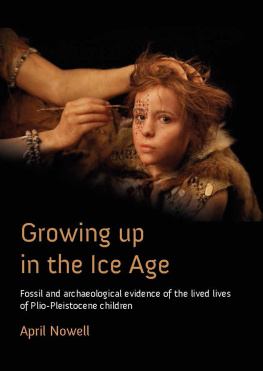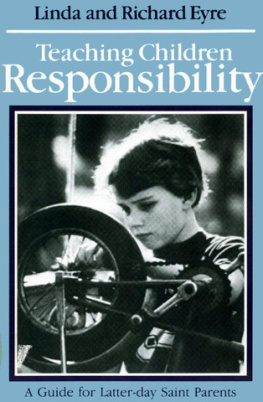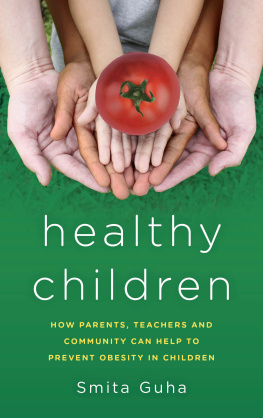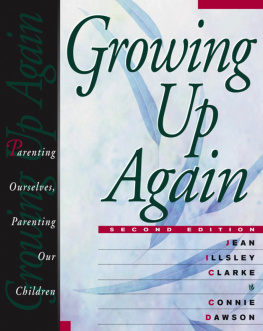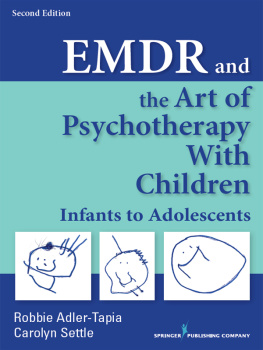Pagebreaks of the print version

Growing Up in the Ice Age
Growing Up in the Ice Age
Fossil and archaeological evidence of the lived lives of Plio-Pleistocene children
April Nowell
To Lena, James and Ailsa with love
Published in the United Kingdom in 2021 by
OXBOW BOOKS
The Old Music Hall, 106108 Cowley Road, Oxford OX4 1JE
and in the United States by
OXBOW BOOKS
1950 Lawrence Road, Havertown, PA 19083
Oxbow Books and April Nowell 2021
Paperback Edition: ISBN 978-1-78925-294-1
Digital Edition: ISBN 978-1-78925-295-8 (ePub)
Digital Edition: ISBN 978-1-78925-296-5 (kindle)
A CIP record for this book is available from the British Library
Library of Congress Control Number: 2021934332
All rights reserved. No part of this book may be reproduced or transmitted in any form or by any means, electronic or mechanical including photocopying, recording or by any information storage and retrieval system, without permission from the publisher in writing.
For a complete list of Oxbow titles, please contact:
United Kingdom
Oxbow Books
Telephone (01865) 241249
Email:
www.oxbowbooks.com
United States of America
Oxbow Books
Telephone (610) 853-9131, Fax (610) 853-9146
Email:
www.casemateacademic.com/oxbow
Oxbow Books is part of the Casemate Group
Front cover: Sculpture Elisabeth Daynes/Photo: S. Entressangle.
Back cover: Upper Paleolithic children playing with miniature weapons. Drawing: Marina Lezcano.
Acknowledgements
The idea for this book began back in 2009 when I started throwing files into an electronic folder simply labelled Paleo kids. It wasnt until a decade later that the writing of this book took shape but I had spent much of the intervening years, thinking, teaching and publishing on Paleo kids. The majority of this book was written during the Covid-19 pandemic of 2020. I truly hope that as you read this you are thinking, that was awful, I am so glad thats over. As an academic, I was privileged to be able to continue doing my job, teaching and writing, from home. At the same time, limited access to my office and only online access to my universitys library meant that many of the resources I needed were out of reach. This is where so many of my friends and colleagues stepped in to help. People generously sent me PDFs of their work and one friend, Anders Hgberg, went so far as to photograph each page of a critical chapter with his phone and to email them to me one by one.
As Chair of the Department of Anthropology at the University of Victoria during the pandemic, my administrative load was heavier than usual. I had to oversee the shutdown of our department and transition to online teaching and the gradual return to work when it became safe to do so. In stepped more generous friends. Lisa Mitchell, Brian Thom, Daromir Rudnyckyj, Helen Kurki and Andrea Walsh each took on Acting Chair duties so that I could have nine weeks of mostly uninterrupted writing time. While this pandemic has brought with it many sadnesses, it has also brought home the kindness, good humor and supportive nature of those I am grateful to have around me.
In this context, I would like to thank the following people for sending me PDFs, commenting on earlier drafts, providing me with figures or generally being supportive of this endeavor and my sincere apologies to anyone who was inadvertently left out: Chris Ames, Traci Ardren, Paul Bahn, Stephanie Baker, Jane Eva Baxter, Gerhard Bosinski, Lisa Brown, Stephanie Calce, Maureen Carrol, Melanie L. Chang, Jean Clottes, Ben Collins, Amanda Cooke, Elizabeth Craig-Atkins, Dale Croes, Iain Davidson, Francesco dErrico, Rebecca Farbstein, David Frayer, Carole Fritz, Khaled Hakami, Sin Halcrow, Anders Hgberg, Helen Kurki, Liudmila Valentinovna Lbova, Mary Lewis, Marina Lezcano, Stuart Lipkin, Charlotte Mackie, Quentin Mackie, Lisa Mitchell, Mark Moore, Magen OFarrell, Susan Pfeiffer, Frdric Plassard, James Pokines, Felix Riede, Lisa Rogers, Aurora Skala, Dan Stueber, Meghan Strong, Nancy Tatebe, Gilles Tosello, Leslie Van Gelder and Alexei Vranich. Thank you also to Prof. Anne-Marie Tillier who first inspired me, through her publications, to start thinking about Neandertal children when I was still a graduate student. I thank Lisa Rogers for research assistance and Jeremy Beller for research assistance and masterful figure preparation.
Similarly, I especially thank Kirsten Blomdal for all of the hours she spent compiling data for many of the tables in this volume as well as for all of her work formatting and cross-referencing the bibliography and text. It was a massive undertaking and I am truly grateful for everything she has done. I thank Elisabeth Daynes (the Atelier Daynes) for the beautiful cover art and Jane Baxter for generously agreeing to write the foreword. Janes pioneering work remains an inspiration for me. I would also like to thank my ever patient and kind editor at Oxbow, Jessica Scott, for believing she would eventually see a manuscript.
I thank my husband, Jon Miller, who was beginning to feel as if he was living through the writing of my dissertation a second time but continually encouraged me to put words on pages and my children, Lena and James Miller, and my niece, Ailsa Miller, for being inspirations it is no accident that I began with an interest in children and the evolution of play behavior and developed an interest in the unique contributions of teens as you all grew. Finally, I thank James Pokines, who back in 1999 suggested we write a paper together on children in the Paleolithic and to whom I replied, I am not sure we know enough to write anything. You have never said I told you so. Drinks are on me.
Foreword
Let me begin by simply saying that this book is an incredibly significant development in the trajectory of childhood studies in archaeology. With that proclamation made, let me explain why. The reasons are many.
Early scholarship on the archaeology of childhood focused on identifying traces of children and their lives in the skeletal and material records at archaeological sites. Children were often analyzed in isolation simply to demonstrate their presence could be identified, and that such an identification was useful in archaeological inquiry. These fundamentals were needed at a time when the archaeology of childhood was primarily invested in demonstrating the visibility and viability of children in the archaeological record to justify its pursuit by scholars. Chapter 1 of this book is a potent manifesto of why children traditionally have been understudied in archaeology, and why those reasons dont hold up to scrutiny. Dr Nowell makes a strong case for a reconfiguration of our archaeological approaches to the past to be more inclusive in our interpretations and understandings of those who lived before us. As a long-time scholar of children in archaeology, I found myself mentally applauding, fist pumping, and shouting, Amen to the resounding declarations made in the first chapter: Children were present in the past. Children were important in the past. An archaeology without children is one that is fundamentally lacking in its interpretation of the past.
Taking such a view has resulted in more sophisticated understandings of children in human communities, and frequently involves an explicit or tacit focus on the relational nature of childhood. Relational approaches tell us that children belong to a category of person that is defined in relationship to other such categories. Children are understood as being different from adults, infants, adolescents, or others depending on the culture under study, and the boundaries between these categories are actively negotiated and regulated. Relational understandings of childhood demand an exploration of the relationships that create these categories and the boundaries between them. Growing Up in the Ice Age is a work that embraces the relational nature of childhood as a key underpinning, placing children as active agents in human communities through familial relationships, rituals in life and death, and communities of practice and artistic production. Chapter 6 focuses exclusively on adolescence a category of personhood we are only beginning to appreciate and understand in archaeology, but one that also relies on a relational understanding of personhood. In this way, this book is definitely childhood archaeology 2.0 one that assumes the presence of children and firmly situates them within human communities in rich and complex ways.

